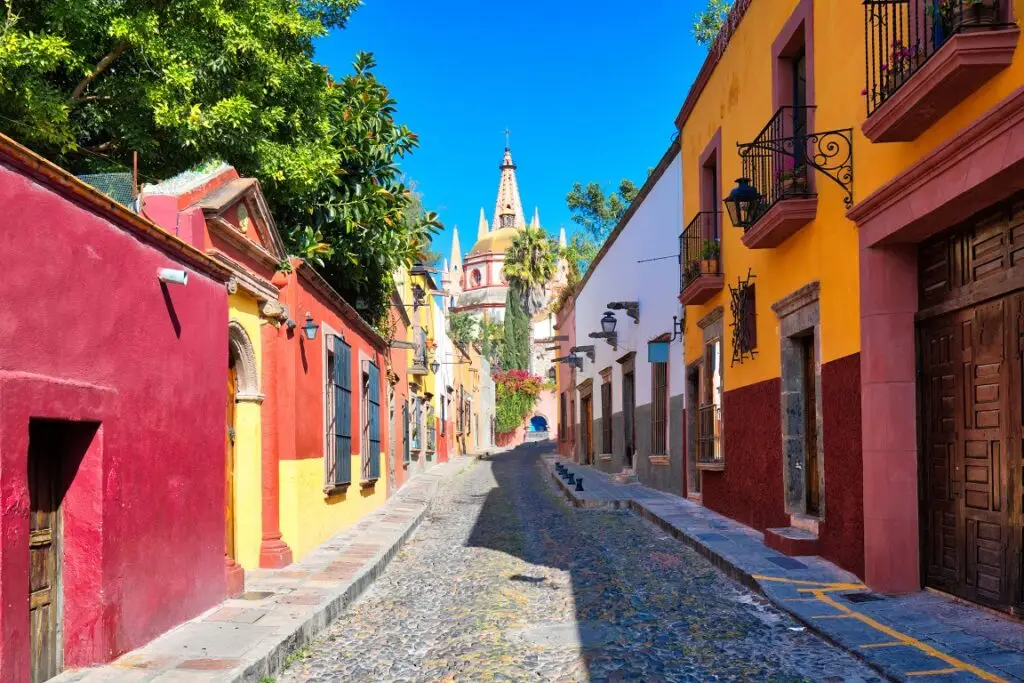
SAN MIGUEL DE ALLENDE
San Miguel de Allende (Spanish pronunciation: [san migel de ayende]) is the principal city in the municipality of San Miguel de Allende, located in the far eastern part of Guanajuato, Mexico. A part of the Bajío region, the city lies 274 km (170 mi) from Mexico City, 86 km (53 mi) from Querétaro, and 97 km (60 mi) from the state capital of Guanajuato.[4] The city’s name derives from two persons: 16th-century friar Juan de San Miguel, and a martyr of Mexican Independence, Ignacio Allende, who was born in a house facing the city’s central plaza. San Miguel de Allende was also a critical epicenter during the historic Chichimeca War (1540–1590) where the Chichimeca Confederation defeated the Spanish Empire in the initial colonization war. Today, an old section of the town is part of a proclaimed World Heritage Site, attracting thousands of tourists and new residents from abroad every year.
At the beginning of the 20th century, the town was in danger of becoming a ghost town after an influenza pandemic. Gradually, its Baroque/Neoclassical colonial structures were “discovered” by foreign artists who moved in and began art and cultural institutes such as the Instituto Allende and the Escuela de Bellas Artes. This gave the town a reputation, attracting artists such as David Alfaro Siqueiros, who taught painting.
This attracted foreign art students, especially former U.S. soldiers studying on the G.I. Bill after the Second World War. Since then, the town has attracted a significant number of foreign retirees, artists, writers and tourists, which has shifted the area’s economy from agriculture and industry to commerce catering to outside visitors and residents.
The United Nations Educational, Scientific and Cultural Organization (UNESCO) designated the Protective town of San Miguel and the Sanctuary of Jesús Nazareno de Atotonilco as a World Heritage Site in 2008. The area of designation includes part of the town San Miguel de Allende and part of the town of Atotonilco, which are about 14 kilometers apart.
The World Heritage Site is highlighted by a core zone of 43 hectares in San Miguel de Allende’s well-preserved historic center, filled with buildings from the 17th and 18th centuries. The other part of the World Heritage Site fourteen kilometers north, at the Sanctuary of Atotonilco, has a core zone of .75 hectares surrounded by a buffer zone of about 4.5 hectares.
Foreign influence
According to biographer John Virtue, “Stirling Dickinson is without doubt the person most responsible for San Miguel de Allende becoming an international art center”. Although only an amateur painter himself, Dickinson became co-founder and director of the Escuela Universitaria de Bellas Artes, an art institute that he opened in a former convent only a few months after his arrival.
Due to its growth as a tourist destination, some of the most obvious culture seen on the streets of the town relates to visitors, both foreign and Mexican. To cater to these visitors, the town contains cafes, boutiques, art galleries, upscale restaurants and hotels, and a wide variety of bars and nightclubs.
Bars and nightclubs range from DJs or loud bands catering to young people, to jazz clubs, sports bars and even those that specialize in traditional Mexican music such as mariachi. Some were founded by foreigners and reflect that ownership, for example the Berlin Bar & Bistro.Just outside Centro, the avant-garde ‘black box’, Shelter Theater offers Open Mic, live concerts, films and intimate theater shows, mostly in English.
Shops around the Jardin Principal sell art, handcrafts, furniture and decorative items. The Fabrica La Aurora is an old textile mill that has been converted into galleries and shops selling art, furnishings and antiques; it has a lot of open space along with a café and restaurant.
San Miguel has several schools for learning Spanish, most catering to foreign visitors. These include the Instituto Allende (with credits transferable to U.S. or Canadian colleges), Language Point and Warren Hardy Spanish. Some universities such as the University of Texas-Pan American offer study abroad programs in the city, not only in Spanish but also in arts and literature, and creative writing.
Festivals
Many of the festivals here are purely Mexican, combining social activity with religious expression. Throughout the year there are pilgrimages, all-night vigils, ringing church bells, processions and fireworks.
The largest celebration of the year is that of the town’s patron saint, the Archangel Michael. The angel’s feast day is 29 September, but festivities take place for an entire week. Activities include private parties, sporting events, cultural events, indigenous dance and more.
The week is popularly called the Fiestas de San Miguel de Allende. The finale is a procession of the actual image of St. Michael usually high on the main altar of La Paroquia, and he is taken on a flower-covered dais to “visit” the main churches in the historic district. Fireworks are a part of all festivities. Elaborate structures that spin and light in sequence, called “castillos”—castles—are installed in the esplanade at the Jardín, and sometimes at other churches in town.
Holy Week begins with an exhibition of altars dedicated to the Virgin of Sorrows and end with the Procession of Silence. Prior to the Procession of Silence, there is a reenactment of the judgment of Jesus by Pontius Pilate, on one side of the San Miguel Parish.
Then the procession begins, which represents the fourteen scenes of the Passion before his crucifixion. Many of the townspeople participate in the event, with children dressed as angels and adults in period clothing carrying statues of Jesus.
The procession winds its way along the main streets of the historic center completely in silence. Another large religious celebration is the feast of Nuestro Señor de la Columna.
There are also secular and cultural festivals during the year. The annual Festival de Música de Cámara or Chamber Music Festival occurs each year in August in the city’s historic center. One of the purposes of the event is to bring this type of music to streets and other public venues as well as traditional concert halls such as the event’s home, the Angela Peralta Theater.
Other events include the Jornada de Cultura Cubana in March, the Festival de Tìteres in April, the Festival de Convivencia y Hermandad Universal in May, the Desfile de Locos in June, the Festival Expressiones Cortos in July, the Feria Nacional de Lana y Latón and the festival de Jazz y Blues in November and the Festival de San Miguel de Allende in December.
The most-important political celebration is the reenactment of the “Grito de Dolores“, as the original occurred in the nearby town of Dolores Hidalgo, marking the beginning of the Mexican War of Independence. As the birthplace of Ignacio Allende, the town was a focal point of 2010s Bicentennial celebrations, with reenactments of events such as the arrival of the message from Querétaro from Josefa Ortiz. Bicentennial celebrations also included events such as the Ballet Mazatl. Festivities were concentrated in and around the Jardin Principal, the Ignacio Allende House and the Centro Cultural.
SMART is a multi-media cultural festival, held annually in May, that combines exhibits by Mexican artists with a variety of culinary and social events at local hotels, including the festival founder Hotel Matilda, Dos Casas Hotel and L’Otel.
Demographics
Despite being less than 5% of the total municipal population, foreign residents have considerable cultural and economic impact.
Most foreign residents are retirees from the United States, Canada, and Europe attracted by the mild climate, cultural opportunities, and low crime. It is only a ten-hour drive from the U.S. border.
Many of the home buyers are from this segment of the population as well. Estimates of foreign residents range from 20,000 to 25,000, with at least half of these from the United States.
The large foreign presence has established a number of institutions here, most notably the Biblioteca Pública in the former convent of Santa Ana, which has the second-largest English-language book collection in Mexico and serves as a community center for foreigners.
There is also a chapter of the Lion’s Club (est. 1987). A post of the American Legion and the Veterans of Foreign Wars is located there, as well as Mexico’s only Audubon Society chapter.
While the town and municipality have grown since the coming of foreigners in the 1940s, the highest rates of growth occurred between 1980 and 2000, rising from 77,624 to 110,692, or about 43%.
However, since that time growth has slowed and as of the 2005 census, the population stood at 139,297.[contradictory] Most of the drop has been due to the fall in birthrates. However, the overall population of the municipality is young: about 40% is under the age of 15, with those between 15 and 64 making up about 54% of the population. While the majority of the population of the municipality of Allende lives in a collection of small rural communities that do not exceed 2,500 people, the largest single population center is the town of San Miguel de Allende, which houses 59,691 people, about 44% of the municipality’s population. The next three largest towns each have populations smaller than 3,000 people: Los Rodríguez (2,768), Colonia San Luis Rey (1,850), and Corral de Piedras de Arriba (1,701).
These smaller communities are populated by the municipality’s indigenous groups, mostly Otomi and Nahuas.
The Otomi are the largest group, accounting for just under 38% of the municipal population. The Nahuas follow at about 20%. Other groups include the Mazahua, Huasteca and Purépecha. However, according to the 2002 census, only 520 people speak an indigenous language, 472 of whom also speak Spanish.
Catholicism is practised by 96% of the population, with most others being Protestants, among them Evangelicals. \The municipality is home to three institutions of higher education, the Instituto Tecnológico SSC, a campus of the Universidad Tecnólogica de León, and the Universidad Tecnológica de San Miguel de Allende.
The city also has bilingual schools that follow the curriculum of the American educational system. As of 2000, 17.5% of the population is considered to be illiterate, compared to 12.1% for the rest of the state.
